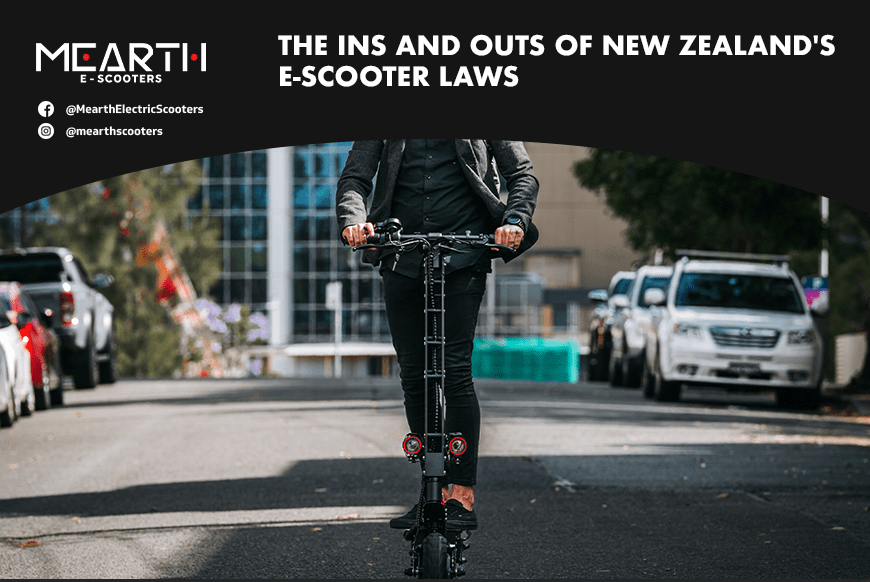Have you ever wondered what it takes to ride an electric scooter, or e-scooter, in New Zealand?
You might be surprised to learn that you don’t need a driver’s license or a registration plate to zip around on these fun and eco-friendly vehicles.
Did you know that mobility devices are motor vehicles that were initially designed and constructed for people needing help with mobility because of physical or neurological impairment and powered by a motor of up to 1500 watts?
It doesn’t mean though you can ride them anywhere and anyhow you want. As there are some important rules and responsibilities that you need to follow to ensure your safety — and the safety of others.
This article aspires to give you an extensive guide to the legal requirements, safety tips and best practices for using electric scooters in New Zealand.
The electric scooter laws in New Zealand are often perplexing, as new regulations are frequently introduced, leading to a sense of bewilderment.
It would seem that there are a lot of unclear laws surrounding electric scooters, such as whether you can get done for drink driving, how power limits are calculated, and what types of scooters are considered mobility devices.
According to the Waka Kotahi NZ Transport Agency, these are the electric scooter laws in NZ:
Some of the ins of electric scooter laws in NZ –
- They are regulated by the New Zealand Transport Agency (NZTA), which states that an electric scooter or e-scooter is a low-powered vehicle that has a footboard, two or three The electric scooter consists of wheels, a lengthy steering handle, and an auxiliary propulsion motor powered by electricity. The wheel size should not exceed 355mm, and the motor’s maximum power output must not exceed 300W.
Some of the outs of electric scooter laws in NZ –
- The maximum power output of an e-scooter is not necessarily the same as the maximum wattage stated of the electric motor, and can be lower depending on the battery voltage, controller’s maximum amperage output and motor’s peak efficiency.
- When using the electric scooter on the footpath, it is essential for the user to exercise caution and consideration, ensuring a speed that does not endanger other footpath users. The user must give way to both pedestrians and drivers of mobility devices. On the road, e-scooters should be operated as close to the edge of the roadway as possible.
However, they must be ridden on the footpath whenever possible, and if they are used on the road, they must meet vehicle standards for lighting, brakes and tyres.
These mobility devices or battery-run vehicles must also be registered and licensed before they can be used on the road, and the user must wear an approved safety helmet.
Although wearing a helmet is not a legal requirement for e-scooter use, it is highly recommended. As long as the electric scooter’s wheels are no larger than 355mm and the motor’s maximum power output does not exceed 300W, there is no need for registration or a driver’s license.
Electric scooters offer the benefit of increased mobility, travel choice and efficiency.
Some of the ambiguous* electric scooter laws in NZ —
*(unclear, uncertain, confusing)
- There is no clear definition as to what constitutes a mobility device, which is designed and constructed for people needing help with mobility because of physical or neurological impairment and powered by a motor of up to 1500 watts.
- NZTA states that fat-tyre electric scooters, which are often sold as ‘mobility devices’, are not mobility devices, but rather LA-Class mopeds, which require registration, driver license, warrant of fitness inspection, vehicle standards and helmet requirements.
- E-scooters are legal in New Zealand, but they have to follow certain regulations and safety guidelines.
- E-scooters can be used on the footpath or the road, except in designated cycle lanes. They have to give way to pedestrians and mobility devices on the footpath, and keep as far to the left as possible on the road.
- E-scooters must be equipped with the same features as bicycles: lights, brakes, reflectors, and a bell. They must also have an auxiliary electric motor with a maximum power not exceeding 300W.
- A helmet is not legally required to be worn when using an e-scooter, but it is strongly recommended.
- Other safety tips include riding at a safe speed, being aware of other road users, and wearing bright clothing.
- While it is accepted that e-scooters offer many benefits such as increased mobility, convenience, and environmental friendliness, they are also perceived to pose some risks such as causing injuries, accidents, and conflicts with other road users. Although in reality, the responsibility lies on the e-scooterist or rider, caused by his deliberate disregard, neglect, and recklessness,not being mindful of the law.
- It is best to be on the safe side: ride one’s electric scooter but proceed with caution. Be a responsible e-scooterist, follow carefully and be respectful of New Zealand’s basic road rules.



